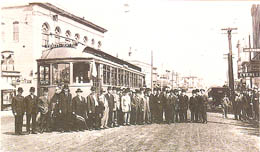On April 30, 1910, the Seattle-Everett Traction Company inaugurates electric interurban rail service with a 10 a.m. run from Everett to Seattle. Scheduled service begins two days later and continues until February 20, 1939, when the region's last interurban line is abandoned.
Fred Sander launched construction of an interurban railway between Seattle and Everett in 1900, but it took him six years to complete six miles of track between Ballard and Hall's Lake. The regional subsidiary of the giant Stone & Webster utility cartel purchased Sander's line in 1909 and organized the Seattle-Everett Traction Company to operate it. Stone & Webster already managed Seattle-Tacoma interurban service.
Shaped North Seattle
The Seattle-Everett line extended from downtown Seattle near today's Westlake Center, ran north to Fremont via Westlake Avenue, up Phinney and Greenwood avenues, and then followed a route later paralleled by Highway 99. This service played a major role in promoting the development of Seattle's northern neighborhoods and suburbs and spurred development of local business districts such as Greenwood.
The Seattle-Everett interurban was reorganized as the Pacific Northwest Traction Company in 1912. The company built a second line from Mount Vernon to Bellingham but failed to complete the missing rail link between Everett and Mount Vernon. It introduced motor buses to shuttle passengers between the two terminals, and integrated bus and rail service as the North Coast Lines in 1927. That same year, the company built a handsome new downtown Seattle terminal, which survives as the Greyhound depot.
End of an Era
Completion of Highway 99 in 1932, growing competition from automobiles, and Seattle's decision to scrap its streetcar system doomed the line. The last run left Everett for Seattle at 11 p.m., February 20, 1939. Some of its large electric cars ended up as roadside diners, and the rest headed to the scrap yard.
Federal anti-trust rulings dissolved the national Stone & Webster cartel in 1934, and its Puget Sound Power & Light Company was reorganized under local control. In 1946, federal regulators ordered Puget Power to divest North Coast Lines, ending its involvement in interurban transportation.

